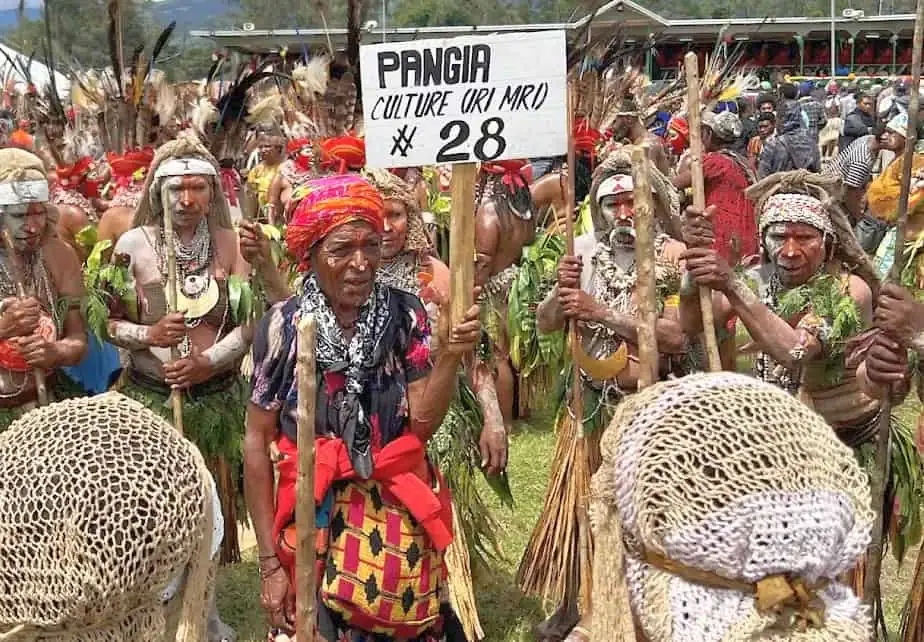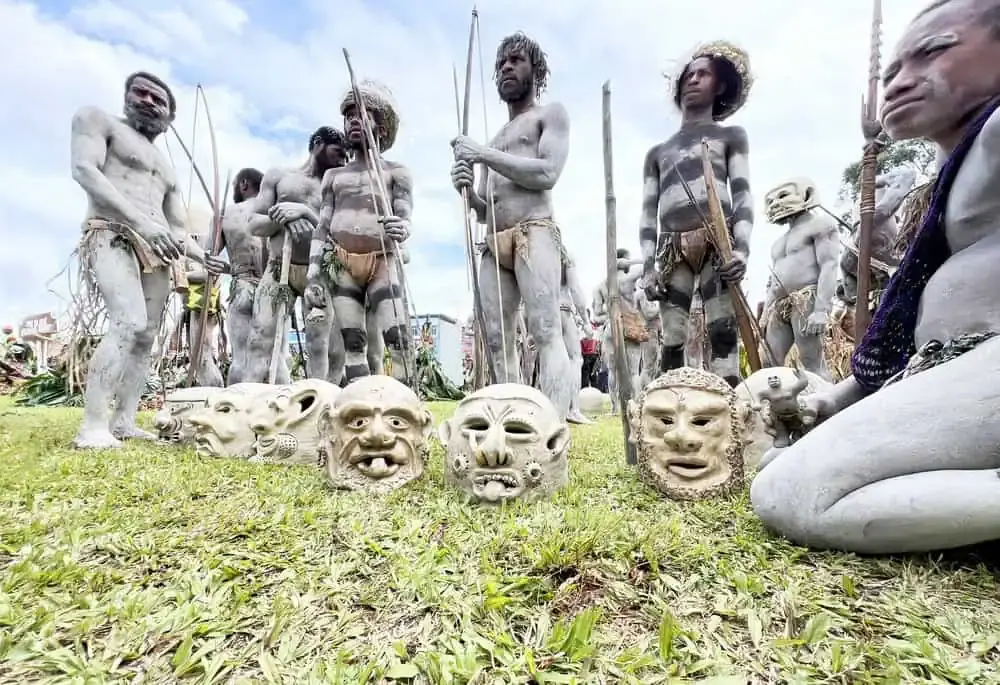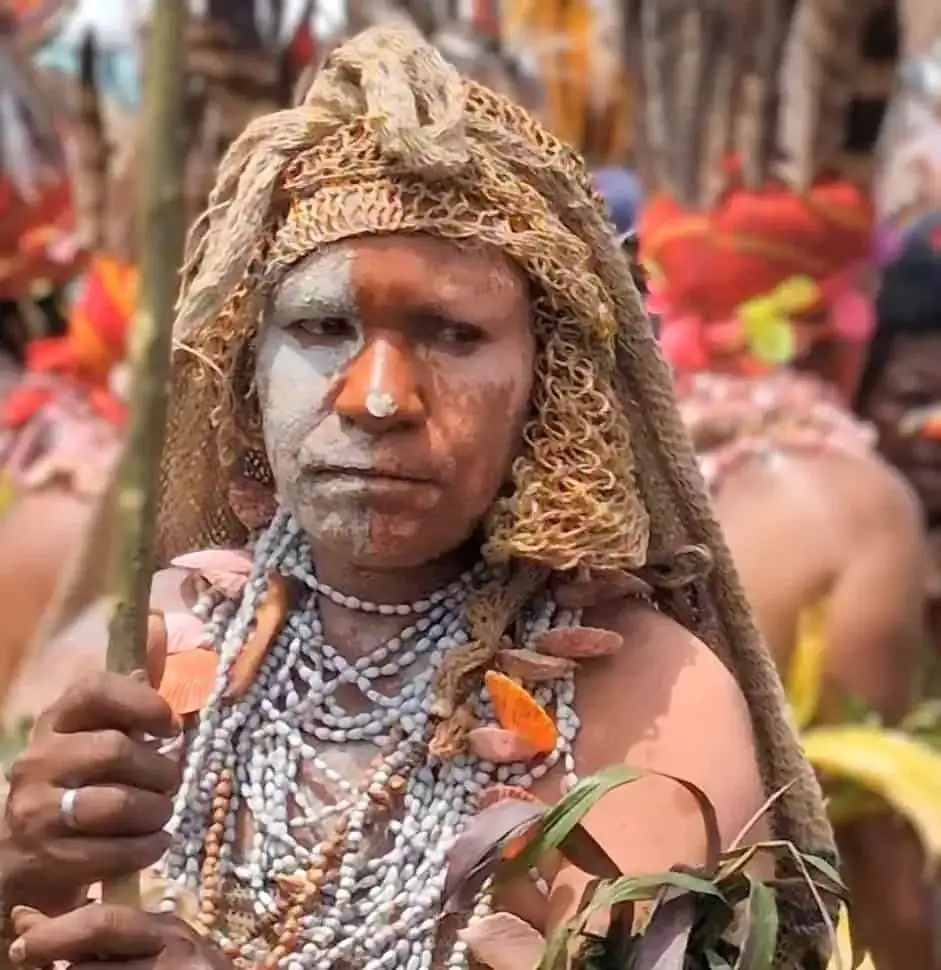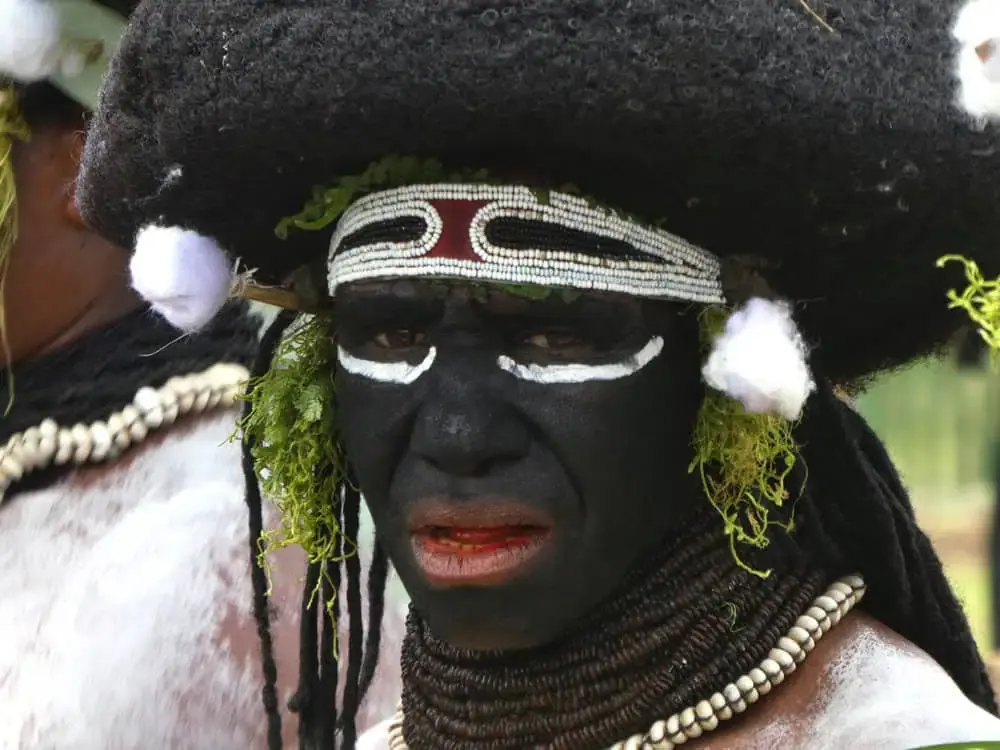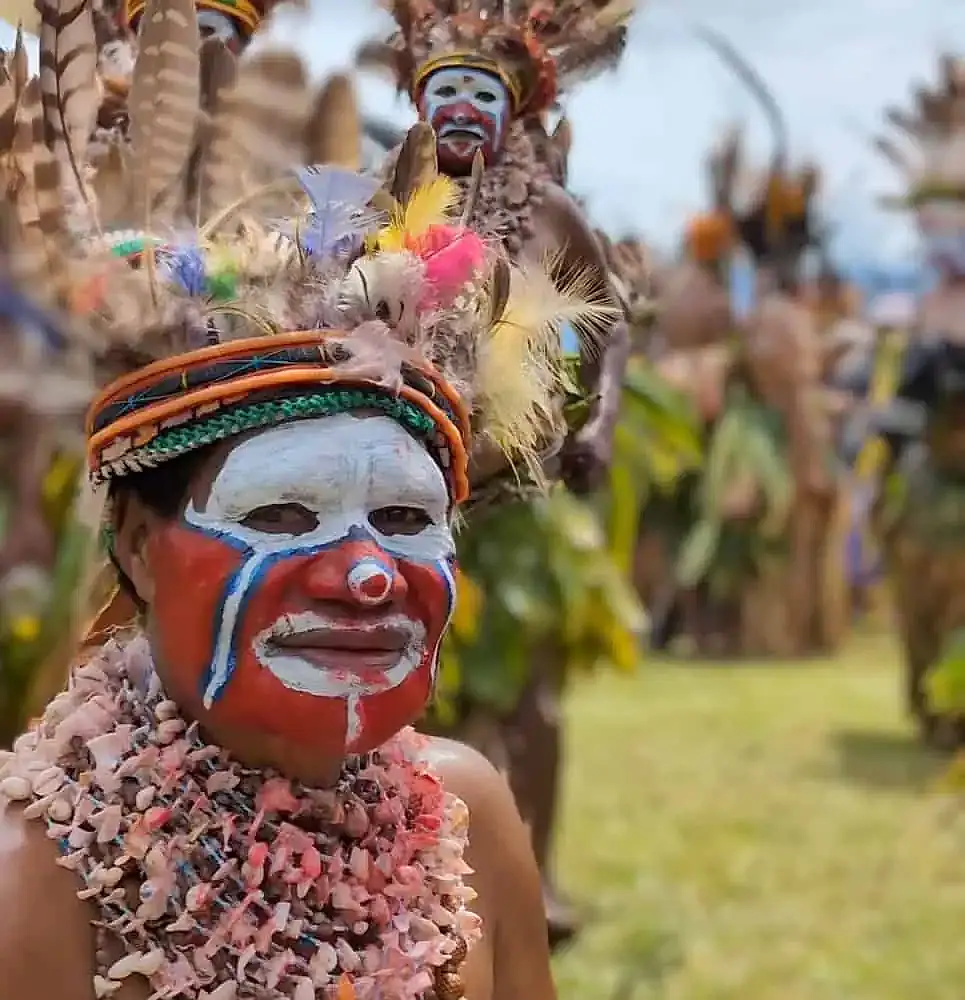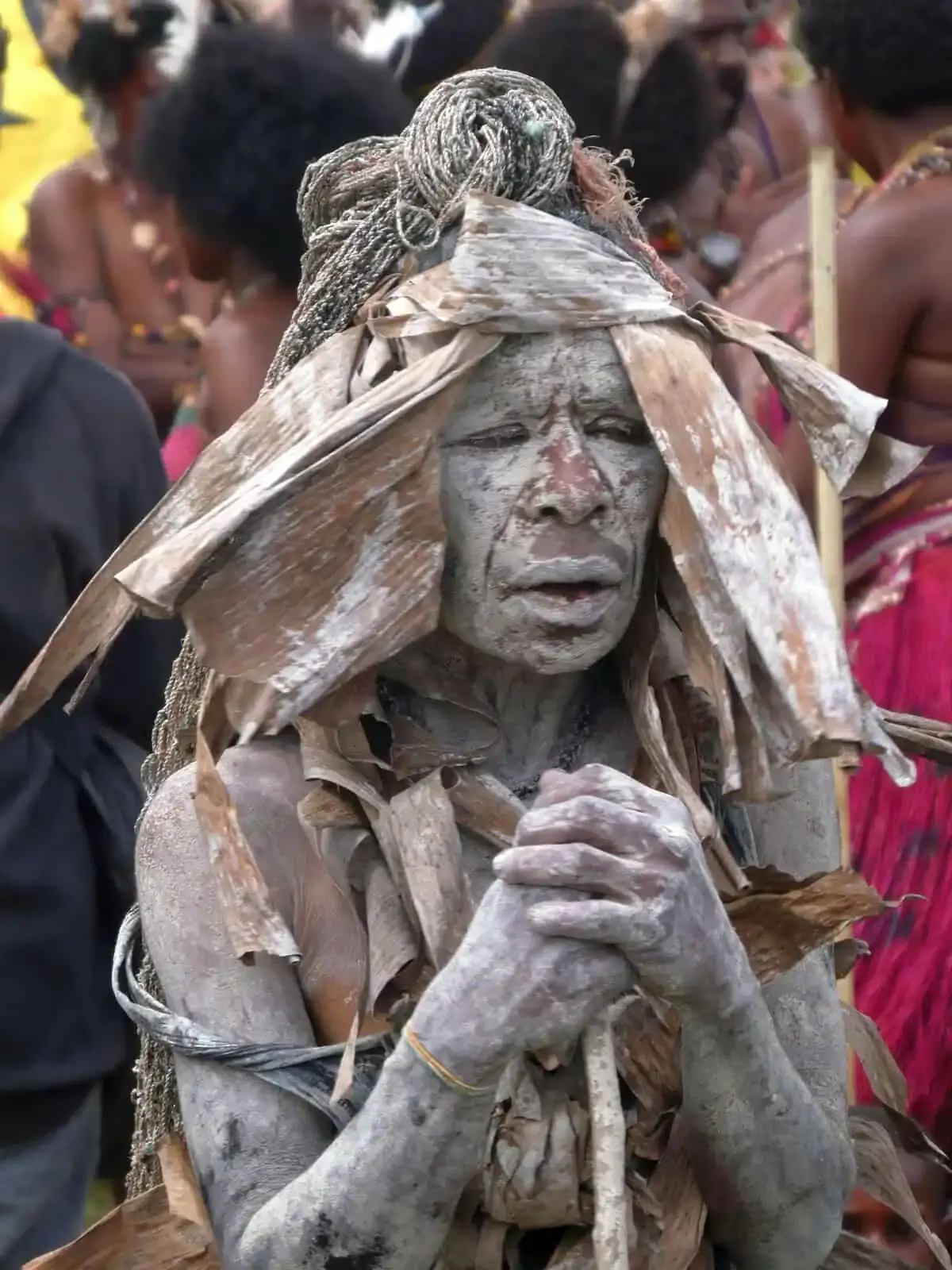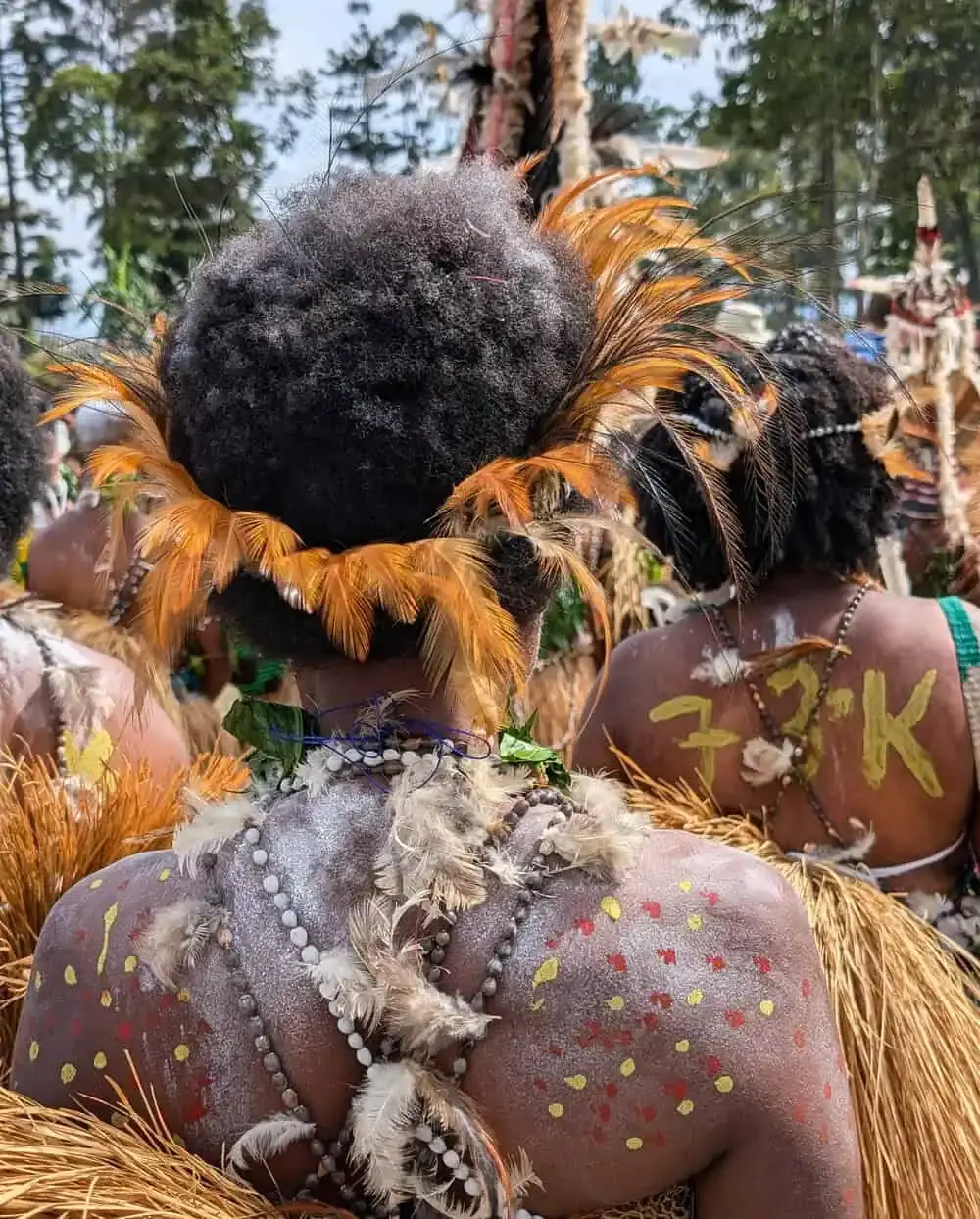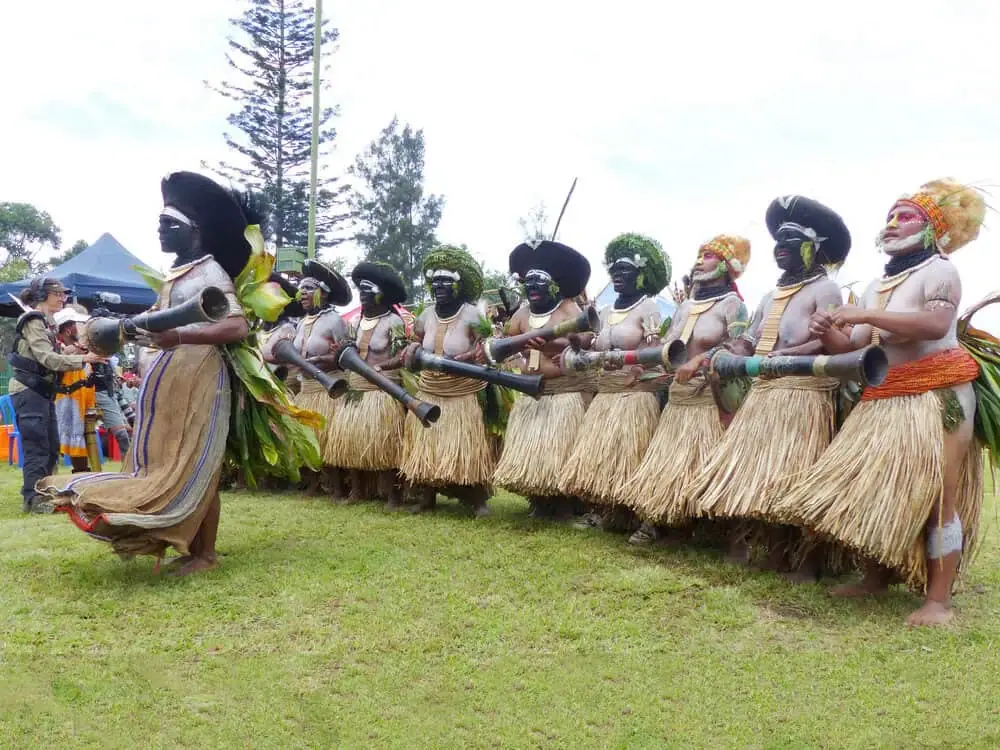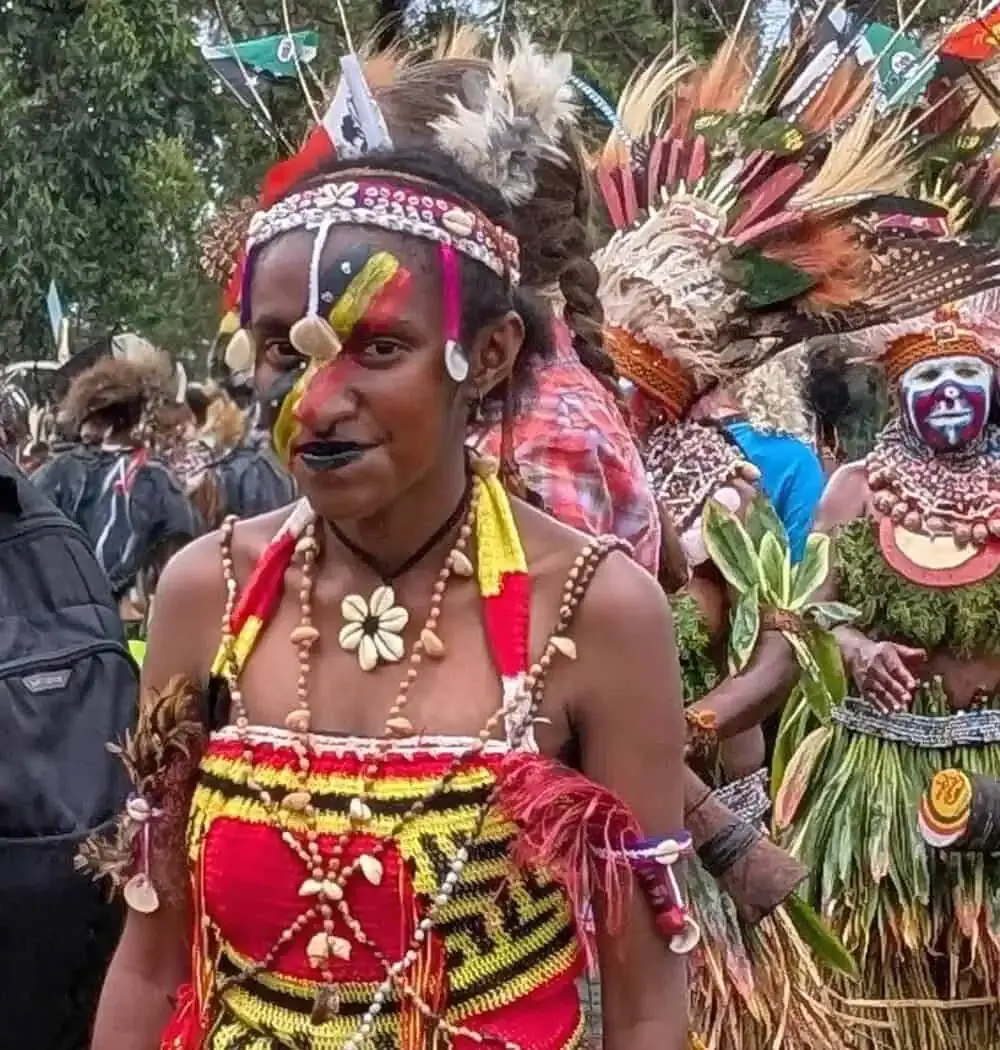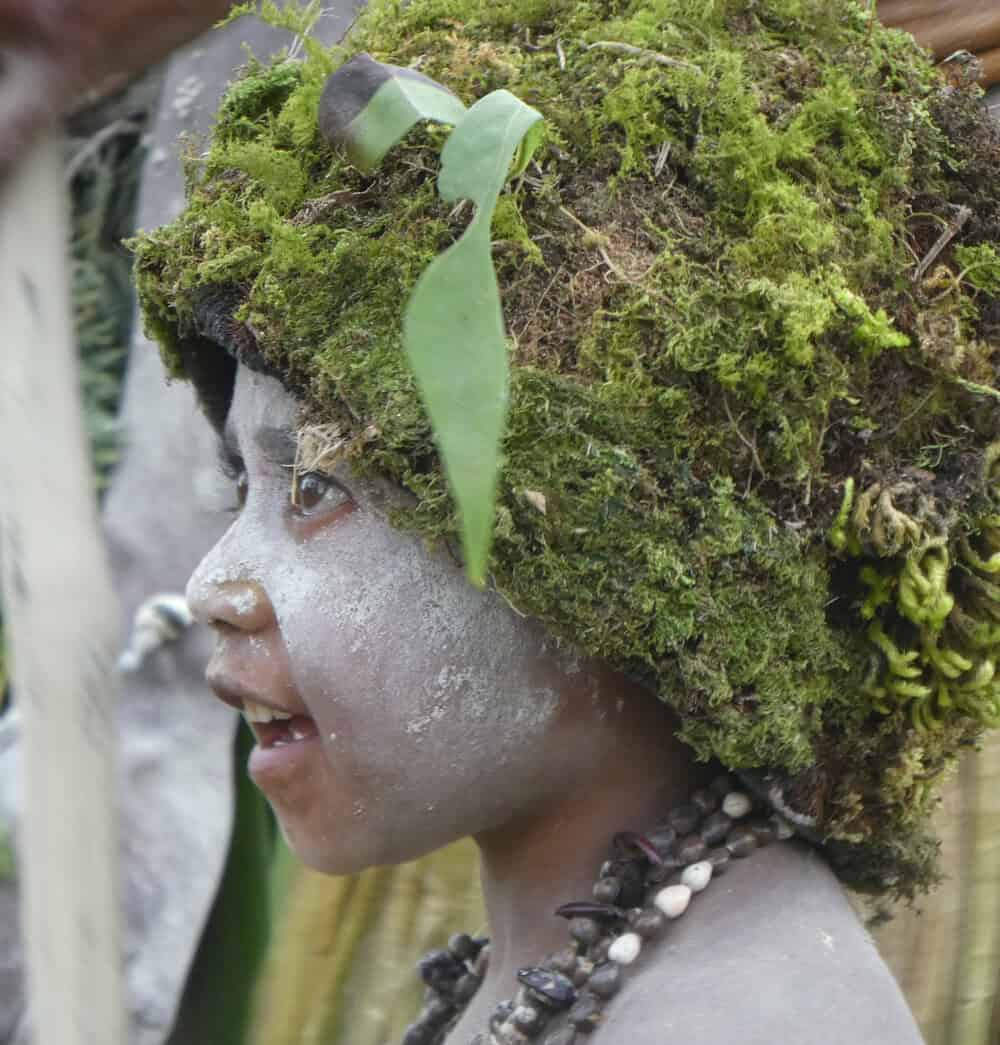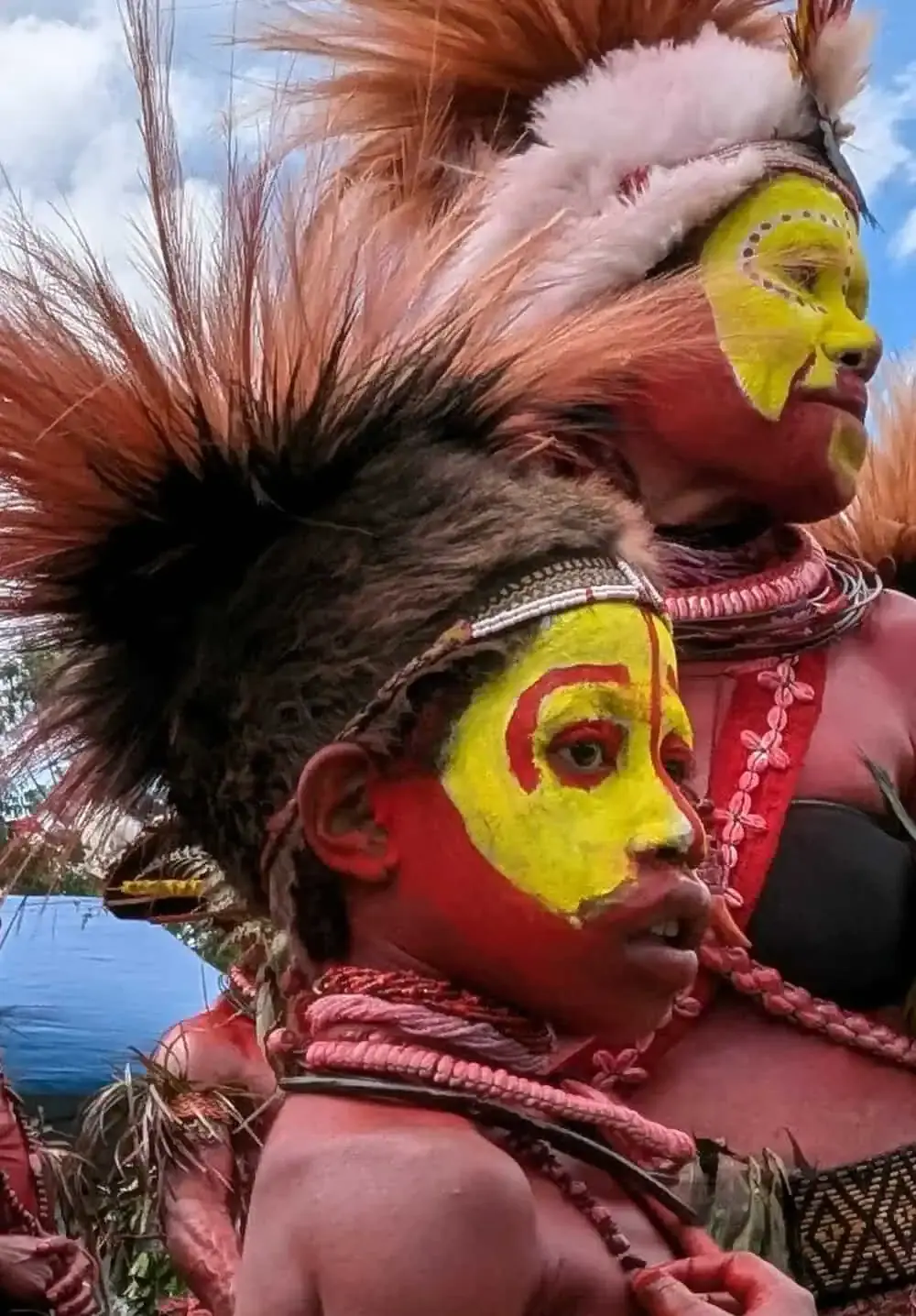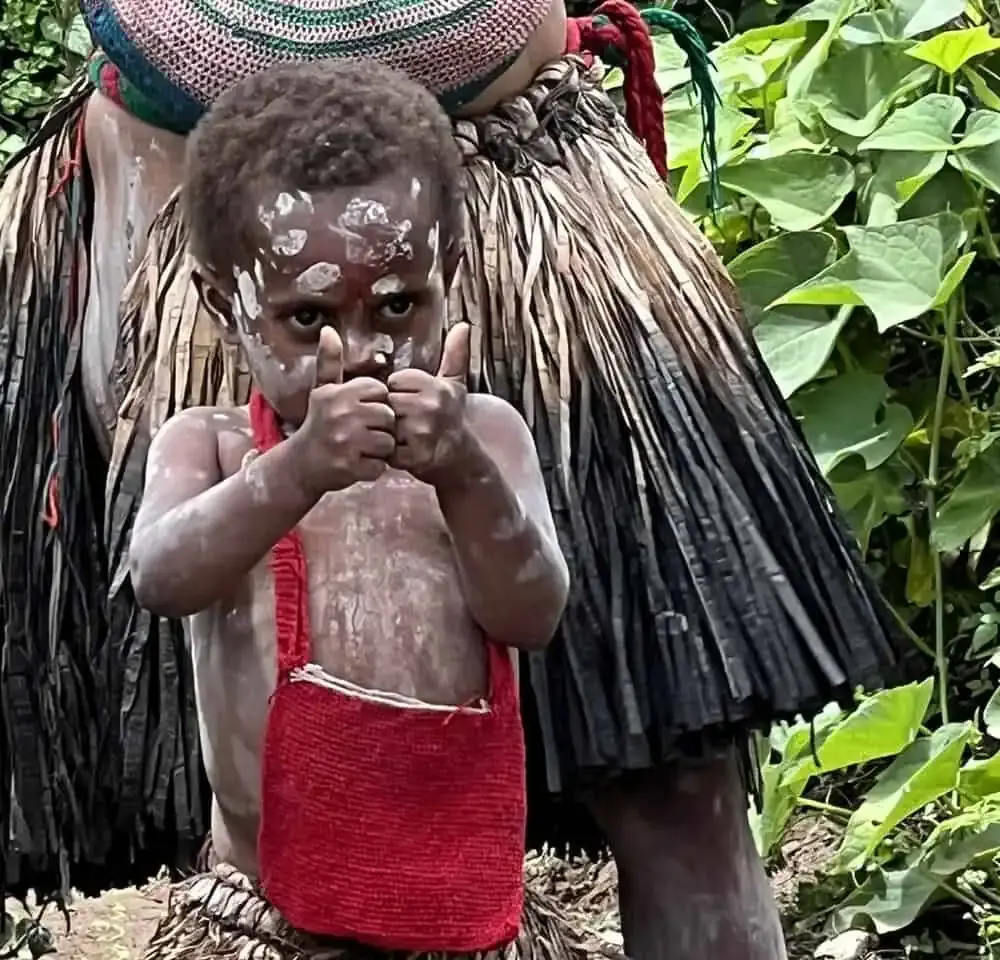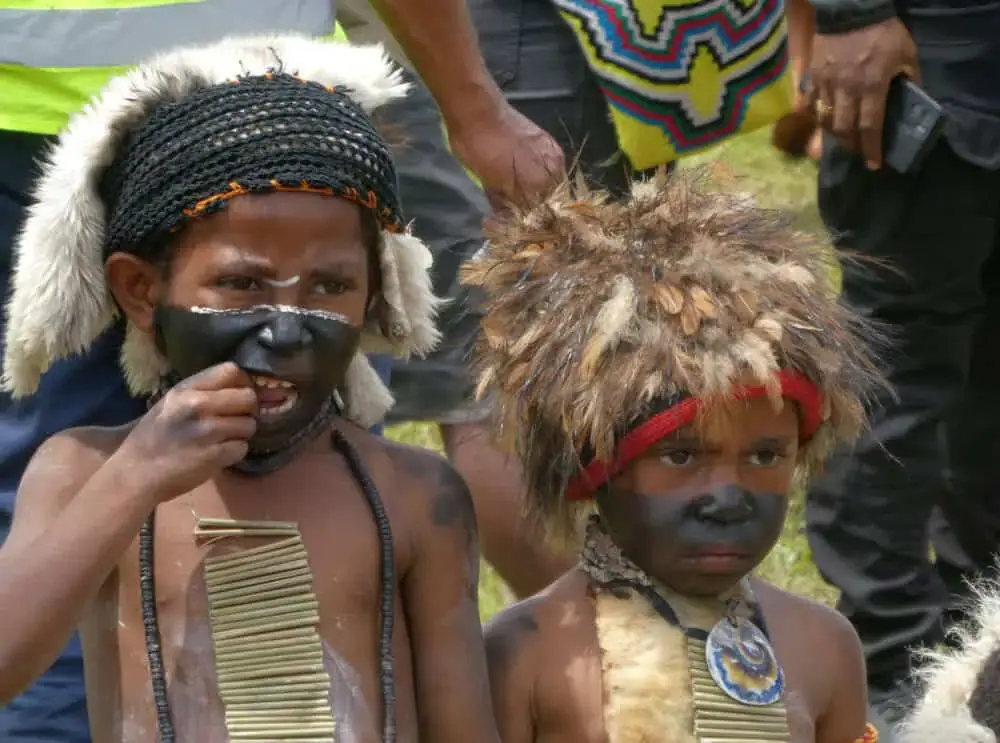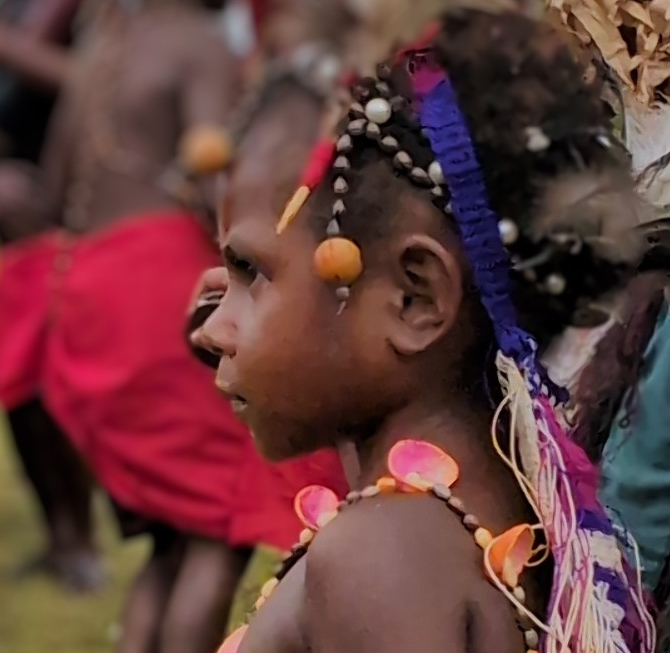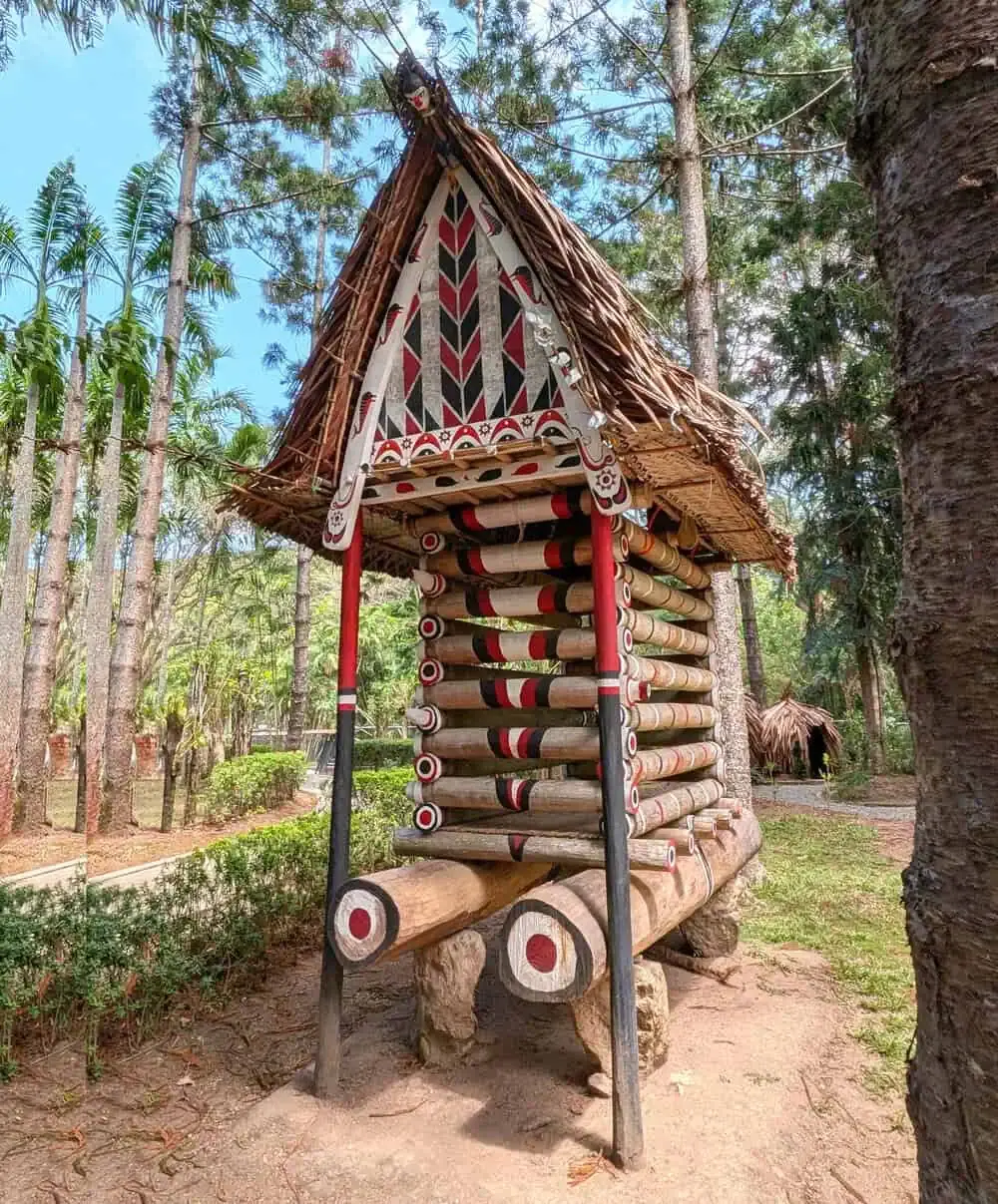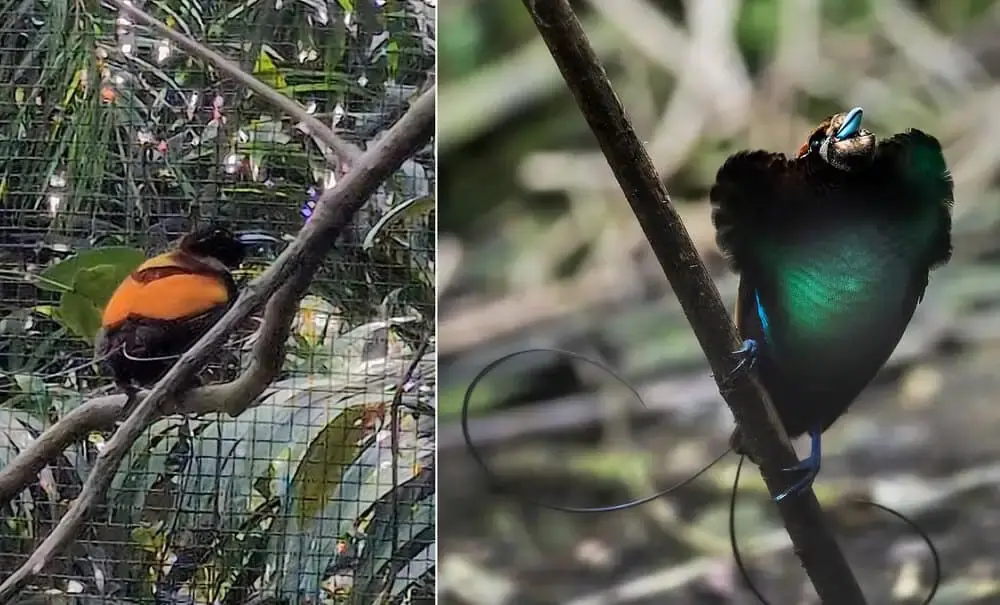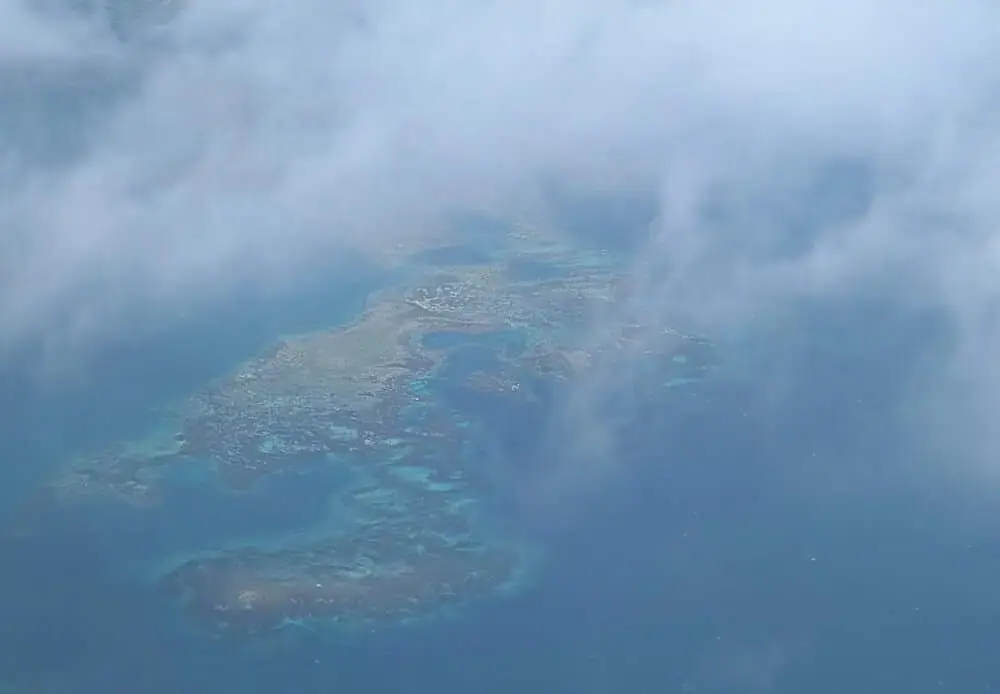Up next: a sensory explosion of dance, tribal culture, and clashing worlds amidst tourist pandemonium at the Mount Hagen Sing Sing!
The BIG DAY finally arrived. Since we were scheduled to fly late afternoon back to Port Moresby, we checked out with our luggage after breakfast. Jorge, our tour leader, went ahead to troubleshoot the event setup and found, in typical Papua New Guinea fashion, that the original location had just been changed that morning, so the much-touted ‘upgraded bathrooms’ were no more… Arriving early at the new venue, we got our VIP badges and front row seats by the stands, only to be told – surprise! – that the show had been moved to an adjacent cordoned-off field.
Eventually, the different cultural groups filed in to get ready for their performances. The area was reserved for dancers, but there was practically no enforcement. As most of the attendees ended up migrating over there, our group threw in the towel and joined the fray. At its peak, the packed showground was a sea of greenery, feathers, and bodies in motion amidst a babel of chants. The kaleidoscope of sights and sounds was sheer sensory overload…
What was most noticeable was that during our visit, the show was attended exclusively by foreign tourists with VIP passes and their guides. General admission was scheduled to start later in the afternoon – the locals were already massing outside the gates as we left around 3 pm.
The festival had the potential to be an extraordinary photographic experience, but ironically, it left me feeling overwhelmed and frustrated. Overwhelmed because it was challenging to lock onto a subject amidst all the visual cacophony, and frustrated as a result of the appalling behavior of event attendees. Some would randomly barge unceremoniously into performing groups for photo or video ops, while others shoved money into dancers’ hands for poses – a practice Jorge had advised against to prevent the commercialization of tribal traditions.
This pervasive self-absorption – with festivalgoers consumed by their quest for the perfect selfie – left no space for anyone else. As a result, it was almost impossible to take a decent pic or video without getting photobombed or jostled. This frenetic chaos was a far cry from our relaxed and intimate Pre-Sing Sing show at Rodon Ridge yesterday.
All dance troupes carried signs showing their assigned group number and district, village, or cultural group name, but it’s incredibly challenging to find additional info given so little is known about PNG’s numerous ethnic tribes, most of whom live in remote locales. But here’s my collection of pix and videos from the Sing Sing, together with what info I can gather from my research using Gemini, ChatGPT, Perplexity and Copilot.
As seen here, the field was filling up with show participants and their support teams. These women hail from the Pangia district in the Southern Highlands Province of PNG.
The POI Black Mama cultural group is from the Mul-Baiyer District in the Western Highlands Province where the population is primarily Melpa. Having seen the Amazonian physique of the Melpa ladies, this definitely rings true!
The Asaro Mudmen are famous for their powerful performance wearing grotesque clay masks, which could weigh up to 25 pounds. As legend has it, after being defeated in battle, the Mudmen covered themselves in white river mud and donned fearsome masks to masquerade as spirits of dead warriors seeking revenge. Seeing the ‘ghosts’, their rivals were overcome by fear and fled without a fight.
White dot on the tip of a nose is traditional body decoration for women in PNG. Such practices have cultural, aesthetic, or symbolic significance, with each tribe expressing its unique styles and meanings passed down through generations. These markings are typically made using white clay (kaolin), lime, or ash for ceremonial events or Sing Sings.
The Silimuli – also known as Sulimuli or Sunimuli – from the remote, mountainous Enga Province, are highly identifiable at Sings Sings and cultural shows. Sometimes referred to as the Black-Faced Tribe, men as well as women wear face paint of charcoal or ash and oil, as black for them is a symbol of strength and cultural identity. Similar to the Huli Wigmen, Silimuli headdresses can be made of human hair, but include moss, plant fibers, and leaves for structure and embellishment. However unlike the Hulis, their wigs are large and round, almost disk-like, with much less flamboyant feather decorations.
This is likely the Shangai dance that’s performed after a traditional initiation ceremony. The Sulimuli men form a line and move in unison to the beat of kundu drums, brandishing their poles in a display of unity and strength.
The Melpa people – also known as Hageners – live in the Western Highlands Province, primarily around the Mount Hagen District and Wahgi Valley. Based on the trip and subsequent research, Melpa women’s face paint, regardless of location, follows this classic pattern of red base, white highlights with blue outlines, enhanced by some personalized markings. Melpa men, however, exhibit more diverse patterns and a broader palette of bright red, yellow, white, black and blue across different cultural subgroups.
This woman’s nature inspired earth-tone attire and headdress of dried foliage vaguely reminded me of a Huli dama, who plays the role of a forest spirit in their culture, but Jorge surmised she might be an Enga woman in a mourning ritual. Given the paucity of information about PNG’s peoples, it’s impossible to know for sure.
Exuberant body art is everywhere…
I overheard someone claim this was a courtship dance. It certainly seemed plausible given the couples-only performance!
The Silimulli women also wear oversized headdresses, but they’re often made entirely of leaves and other vegetation, resembling partially flattened green spheres as shown here.
This young lady, nattily decked out in strings of shells, was sporting the red, black, and yellow colors of the PNG national flag across her face.
Called the Polga Lifestyle Culture Group, this troupe’s mission is to preserve local art, dance, and music through performances for tourism and educational purposes.
Here’s someone with the contemporary rendition of a feathered crown.
These dancers were eye-catching in a couple of ways. While all the men pranced jauntily with their koteka (penis gourds), the women by contrast were very modestly covered. Since no one was around to expound on the dance, why this was so, we’ll never know.
At this point, one thing was apparent – the kids were all incredibly photogenic in their traditional attire, regardless of where they were from. Since I didn’t talk to any of them, I’m sharing these random pix with only location annotations.
Mount Hagen Sing Sing.
Mount Hagen Sing Sing.
Skeleton Men performance, private show at Rodon Ridge lodge day before Mount Hagen Sing Sing.
Huli Village archery demonstration, Tari Valley.
Mount Hagen Sing Sing.
Mount Hagen Sing Sing.
Girl’s top decorated with green betel nuts, Mount Hagen Sing Sing.
Melpa child, private show at Rodon Ridge.
Mount Hagen Sing Sing.
After the usual flight delay, we arrived at Port Moresby around dinner time. Thankfully, there were no activities scheduled till 10 am on our last active day – finally a chance to sleep in!
Next morning’s first stop was the National Parliament, whose grounds are normally accessible on weekends, except for the day we visited, of course… Peering from outside the gates, we spotted the Parliament building, a fusion of traditional culture and modern architecture that was inspired by the indigenous Haus Tambaran (Spirit House). The following stop would have been the historic Hanuabada (Big Village), one of the last stilt villages representing the Motu culture. Unfortunately, security concerns nixed that from our agenda, but we were still able to see the structures from across the bay.
 The group then headed for the Koki Fish Market, where we entertained ourselves checking out piles of fish and shellfish – an unusual selection of whelks, rows of crabs, and what appears to be baby giant clams!
The group then headed for the Koki Fish Market, where we entertained ourselves checking out piles of fish and shellfish – an unusual selection of whelks, rows of crabs, and what appears to be baby giant clams!
The Port Moresby Nature Park showcases PNG’s unique flora and fauna, with cultural displays interspersed throughout the gardens, from tribal totems to this Yam House (Riku) used for storing the food crop. Yams are a staple in the coastal regions and central to their feasts and traditional celebrations. Yam house designs are specific to each clan, and this colorful structure is by the Mwauri clan of the Dayagila Village in the Trobriand Islands.
There were some beautiful birds at the park’s WWII walk-through aviary and flight cages. I could only get the back of this male Magnificent Bird of Paradise, but when displaying, his puffed-up biofluorescent front in teal blue and green is truly something to behold!
As luck would have it, a male Reggiana Bird of Paradise, PNG’s national bird, began displaying just as I walked by, flaunting his bright reddish-orange uppertail coverts at a nearby female in an effort to impress. He then proceeded to bounce energetically along the branch and eventually charged at her after an impressive acrobatic display with his wing and tail feathers.
Though shooting the courtship dance through an enclosure wasn’t ideal, it was certainly better than nothing. I came to Papua New Guinea hoping to see a Bird of Paradise in mating display, and caught it in the most unexpected place. As Jorge told us, expect the unexpected at PNG!
But all good things must come to an end. Next morning, we got to the airport at 3:30 am for our Brisbane flight, only to find long lines greeting our bleary eyes. We eventually made it to the counter, and were astounded when the Air Niuguini agent claimed that we had cancelled our own return tickets. I felt a surreal sense of déjà vu, recalling our hotel’s assertion that we had cancelled our room reservation on check in when we first arrived PNG.
Yet I still couldn’t resist taking one last pic of the island as our plane took off on a later flight. PNG is an incredible country for the adventurous and flexible, offering awesome but challenging birding and amazing cultural experiences for those with an open mind.
Yes, hardly anything went according to plan, and our tour was dogged by a litany of health issues. No one in the group was well 100% of the time: everyone, at some point, was either coughing, sniffling, suffering from turista, or serious bacterial infection. However it’s the infrastructure and cultural challenges that have helped preserve the ancestral ways and sacred traditions of a country home to 1,000 ethnic groups, all living in the Stone Age till just 90 years ago.
But newfound wealth from its natural resources is hurling PNG headfirst into the 21st century, eroding traditional values at a blistering pace. This tour gave me a chance to glimpse into the complex tribal mores, as well as beliefs of its diverse peoples, and experience the Sing Sings’ colorful pageantry in a land that, until recently, time forgot. Go – see for yourself before it’s too late!



